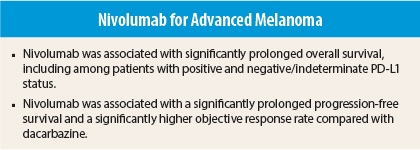In a phase III trial reported in The New England Journal of Medicine, Robert and colleagues found that the programmed cell death protein-1 (PD-1) immune-checkpoint–inhibitor antibody nivolumab (Opdivo) significantly increased overall survival, progression-free survival, and objective response rate compared with dacarbazine in patients with previously untreated metastatic melanoma without a BRAF mutation.1
Victoria Atkinson, MD, of Princess Alexandra Hospital and Gallipoli Medical Research Foundation, Queensland, and Paolo A. Ascierto, MD, of Istituto Nazionale Tumori Fondazione Pascale, Naples, contributed equally to The New England Journal of Medicine article.
Study Details
In this double-blind trial, 418 patients from 80 centers in Europe, Israel, Australia, Canada, and South America with previously untreated stage III or IV melanoma without a BRAF mutation were randomized between January 2013 and February 2014 to receive nivolumab at 3 mg/kg every 3 weeks plus dacarbazine-placebo every 2 weeks (n = 210) or dacarbazine at 1,000 mg/m2 every 3 weeks plus nivolumab-placebo every 2 weeks (n = 208). Patients had to have availability of tumor tissue from a metastatic or unresectable site for programmed death ligand-1 (PD-L1) biomarker analysis. Patients could have received prior adjuvant therapy. Treatment was continued until disease progression or unacceptable toxicity; treatment after disease progression was permitted in patients with clinical benefit and no substantial adverse events from study treatment. The primary endpoint was overall survival.
The nivolumab and dacarbazine groups were generally balanced for age (median, 64 and 66 years), sex (58% and 60% male), geographic region (Europe or Canada for 69% and 70%; Israel, Australia, or South America for 31% and 30%), Eastern Cooperative Oncology Group (ECOG) performance status (0 in 70% and 58%, 1 in 29% and 40%), metastasis stage (M1c in 61% in both; M0, M1a, or M1b in 39% in both), lactate dehydrogenase (LDH) level (> upper limit of normal in 38% and 36%, > two times upper limit of normal in 10% and 11%), history of brain metastases (3% and 4%), positive PD-L1 status (35% and 36%), and prior systemic therapy (adjuvant in 15% and 17%, neoadjuvant in 0.5% in both).
Follow-up and Subsequent Treatment
All randomized patients were followed for up to 16.7 months at the time of database lock, which occurred at 5.2 months after the first visit of the last randomized patient. After discontinuation of study treatment, 63 patients in the nivolumab group (30%) and 114 in the dacarbazine group (55%) received systemic therapy, including ipilimumab (Yervoy) in 45 (21% of all patients) and 79 (38% of all patients), respectively.
Survival Data
The median overall survival was not reached in the nivolumab group vs 10.8 months (95% confidence interval [CI] = 9.3–12.1 months) in the dacarbazine group, and overall survival at 1 year was 72.9% (95% CI = 65.5%–78.9%) vs 42.1% (95% CI = 33.0%–50.9%), yielding a hazard ratio (HR) of 0.42 (99.79% CI = 0.25–0.73, P < .001).
Overall survival was significantly improved with nivolumab among both patients with positive PD-L1 status (median not reached vs 12.4 months; unadjusted HR = 0.30; 95% CI = 0.15–0.60) and those with negative or indeterminate status (median not reached vs 10.2 months; unadjusted HR = 0.48; 95% CI = 0.32–0.71). The survival benefit with nivolumab was also observed across subgroups for age, sex, metastasis stage, ECOG performance status, history of brain metastases, baseline LDH level, and geographic region.
The median progression-free survival was 5.1 vs 2.2 months (HR = 0.43, P < .001).
Response Rates
Responses were evaluated according to RECIST version 1.1. Of note, 8% of patients in the nivolumab arm responded after the occurrence of new lesions and treatment beyond progression. These are “uncommon” responses, or responses assessed according to immune-related response criteria, noted Dr. Ascierto. This finding suggests that we should consider both RECIST and immune-related response criteria in the assessment of patients treated with nivolumab.
The objective response rate was 40.0% vs 13.9% (odds ratio [OR] = 4.06, P < .001), including 52.7% vs 10.8% in patients with positive PD-L1 status and 33.1% vs 15.7% in patients with negative or indeterminate status. Complete response was observed in 7.6% vs 1.0% of patients. Among responding patients, the median duration of response was not reached vs 6.0 months. The median time to response was 2.1 months in both groups.
Reduction of ≥ 30% in tumor burden in the target lesion was achieved or maintained in 17 of 54 nivolumab patients (31%) treated beyond disease progression, compared with 8 of 49 dacarbazine patients (16%) treated beyond disease progression.
Adverse Events
The most common treatment-related adverse events of any grade in the nivolumab and dacarbazine groups were nausea (16.5% vs 41.5%), fatigue (19.9% vs 14.6%), pruritus (17.0% vs 5.4%), and diarrhea (16.0% vs 15.6%). Treatment-related grade 3 or 4 adverse events occurred in 11.7% vs 17.6%, with the most common being diarrhea in the nivolumab group (1% vs 0.5%) and thrombocytopenia (0% vs 4.9%) and neutropenia (0% vs 4.4%) in the dacarbazine group. Treatment-related serious adverse events occurred in 5.8% vs 5.9%, and adverse events led to discontinuation of study treatment in 6.8% vs 11.7%. No deaths were attributed to study drug toxicity.
The study authors concluded: “[N]ivolumab was associated with a significant improvement in overall survival and progression-free survival, as compared with dacarbazine. Nivolumab was associated with a low risk of high-grade toxic effects.” ■
Disclosure: The study was funded by Bristol-Myers Squibb. For full disclosures of the study authors, visit www.nejm.org.
Reference
1. Robert C, Long GV, Brady B, et al: Nivolumab in previously untreated melanoma without BRAF mutation. N Engl J Med. November 6, 2014 (early release online).




